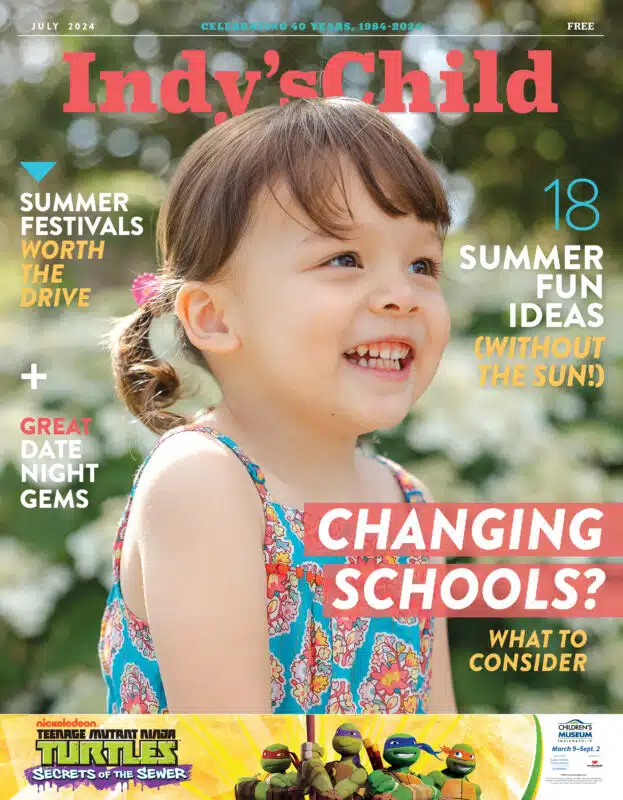Taking little people to the dentist can be stressful. When’s the right time to start? What kind of toothpaste do we use to brush, and when? What if my child is scared of the dentist? Dr. Misti Pratt, Dr. Ana Vazquez and Courtney Bradshaw from Fishers Pediatric Dentistry are here to help with advice and answers to our questions.
At what age should my child begin seeing a dentist?
Pratt: According to the American Academy of Pediatric Dentistry, your child should visit the dentist when the first tooth appears or by the age of one, whichever comes first.
How can I best prepare my child for their first dental appointment?
Bradshaw: Begin oral care as early as possible at home. Encourage your child to participate in brushing and follow up with a quick inspection by having them say “ah” when brushing is complete. Make it playful and fun! Allow your child to look at your mouth or play dentist with an older sibling, favorite toy or stuffed animal. There are great books and videos about visiting the dentist, or you could even make a game out of counting teeth or simply singing a fun song about brushing.
Stay positive. Many parents are anxious about visiting the dentist, so try not to pass those same fears to your child. Explain that visiting the dentist helps keep them healthy. Schedule your child’s visits early in the day when they are most comfortable and happy. Avoid appointments in the afternoon or around nap times.
Be patient. Despite your efforts, your child may still be anxious about visiting the dentist. Use positive reinforcement and encouraging words, and even suggest that they bring their favorite blanket, toy or stuffed animal to their visit. While some visits may start off with an anxious child, the more frequently you visit, the calmer they will become.
When should we start using toothpaste, and how much?
Vazquez: As soon as the first tooth appears, begin brushing twice a day using a fluoridated toothpaste. Use a smear of toothpaste — the size of a grain of rice — from ages 0 to 2, and a pea size amount from ages 3 to 6.
What are the best and worst sweet treats for my child to have?
Bradshaw: As a general rule of thumb, stay clear of the sticky-gooey treats, as they tend to stick between the teeth and linger in the grooves of the teeth. Chocolate is a better choice as it melts in the mouth and can easily be rinsed away. Limit snacking and grazing, avoid prolonged exposure to sugary drinks, drink plenty of water and eat nutritious meals during the day. Consider healthier snacks like yogurt, fruit (not fruit snacks or dried fruit), nuts, veggies, cheeses and popcorn. Avoid grazing on crackers and carbs as these tend to linger in the grooves as well and keep our mouth in cavity mode.
Will thumb sucking affect my child’s teeth?
Bradshaw: The sucking motion is a natural reflex and nurturing/soothing technique that is normal for your child. Depending on how often and vigorously a child sucks their thumb, this habit may or may not affect the growth of the mouth and alignment of the teeth. A prolonged and vigorous habit can often cause an open bite [where the front teeth always look open] and an overbite [how far the top teeth stick out compared to the adjacent lower teeth]. If the habit is stopped early by the age of 3 or 4, problems will usually self-correct.
If you could give parents one piece of advice regarding their child’s dental health, what would it be?
Bradshaw: Understand the process of tooth decay and how to assess your child’s risk, especially concerning diet and frequency of drinking and snacking. This starts as early as birth with daily and night-time feedings and through childhood and adolescence, especially with frequent snacking and consumption of sugary drinks. The things we consume, and frequency of consumption play a big role in the cavity process. It is best to limit grazing throughout the day, and refrain from drinking sugary beverages. Frequency is key to help keep your child cavity free.
Ultimately, each child has different needs and comfort levels. Communicating clearly and honestly with your child’s dentist will go a long way toward making the experience good for everyone. And even if their first visit is a little rocky, future visits are sure to improve as your child learns what to expect — and look forward to the fun little giveaways that are a part of every visit! Happy brushing!







